Tag: Go Orange for Orangutans
Here at Chester Zoo we’re always looking for new tools to help us Act for Wildlife and for the past year we’ve been funding an exciting project developing innovative technologies which will help us conserve the Critically Endangered Sumatran orangutan.
We are supporting Serge Wich, Professor of Primate Biology at Liverpool John Moores University, who is working with two local NGOs, the Sumatran Orangutan Conservation Programme and the Orangutan Information Centre, to pioneer a new method for studying orangutans.
Before we can begin effectively conserving orangutans we need to answer two questions:
1) How many are there?
2) Where are they?
With this information we can set priorities, protect important areas of habitat, target ranger patrols and plan wildlife corridors. Unfortunately orangutans are shy, secretive creatures that tend to hide in thick forest. This makes them rather difficult to count!
Traditionally researchers have to walk long distances through thick, often muddy, forest to find orangutans or the nests they make each night. Serge and his team are using video cameras attached to the latest fixed-wing and quadcopter unmanned aerial vehicles (UAVs) to search for orangutan nests. With this new technology large areas can be surveyed quickly and cheaply, leaving more of our valuable time and money free for other conservation activities!
Serge has already used his UAVs to find orangutans in reforested areas. This is important because it tells us reforesting farmland, palm oil plantations and other degraded areas can create valuable habitat for orangutans.
Whilst the technique is still being perfected Serge is sure to find lots of fascinating applications in the future. You’ll just have to watch this space!
Act for Wildlife and join us in the fight to protect orangutans and their forest home.
As we’re asking you to Go Orange for Orangutans this October, you may wish to polish up on your orangutan facts so you can share with family, friends and colleagues what you know about these amazing animals.
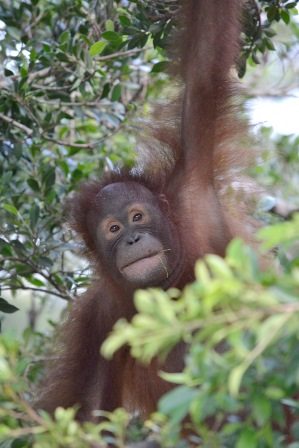
They may also come in handy when you’re asking people to buy a piece of cake you’ve baked to raise money for Go Orange, or when you’re collecting your sponsor money for dying your hair orange!
Basics
Orangutans are the only genus of apes alive in Asia today and are the only existent species in the subfamily Ponginae.
There are two species of orangutan: Bornean and Sumatran. The Bornean orangutans are split into 3 subspecies:
- Northwest Bornean orangutan
- Central Bornean orangutan
- Northeast Bornean orangutan
Orangutans can live for 30 years and females can grow up to 127cm in height and 45.4kg in weight and they have a 9 month gestation period. Infants are dependant for two years and are weaned at 4. By the time they are 6-8 years old they then move away from their mothers.
Male orangutans can grow up to 175cm in height and 118kg in height, with an arm span of 2m! The males do not care for young and between 15-20 years they develop cheek flanges, throat pouches and long hair. There are different mating strategies for flanged and un-flanged males.
Tool Use
There are 54 types of tool use in wild orangutans which include:
- Extract insects or honey
- Opening or preparing fruit
- Napkins
- Gloves
- Cushions
- Poultice for wounds
- Clean teeth
- Swatting insects
Food
Orangutans are opportunistic foragers and eat mainly fruit, however there are 317 types of food that they do eat, including:
- Fungus
- Insects
- Honey
- Leaves
- Bark
- Flowers
- Pith
Other
The largest known species of ape is related to orangutans – this was the Gigantopithecus which could grow up to 3m tall!
t’s nearly time to Go Orange for Orangutans! Are you ready to help raise vital funds for orangutans in the wild? Your support and donations really do make a difference.
Last October you helped us raise £15,000 for our orangutan conservation projects. The funds went directly towards our projects working day in, day out to protect this amazing animal.
The money enabled us to conduct new research using 15 specialist cameras that were vital in studying and protecting orangutans in the wild. Below is an update from HUTAN- Kinabatangan Orangutan Conservation Project (KOCP), a project that we work closely with, that purchased the camera traps which went towards a new research programme.
“Thanks to the generous support of Chester Zoo‘s 2013 Go Orangecampaign, we on the orangutan research team at KOCP are very happy to share these photos from camera traps purchased with these funds. The images below show a wild female orangutan with a clinging baby ‘captured’ just after sunset (18:30) by the infrared setting, moving from the oil palm back to the forest.


“Shown below, is the same female and baby, we believe, from the same camera trap at 17:40 on a different day. In this area, wild orangutans are especially vigilant. This makes it more difficult to follow them in the same ways we are able to within contiguous forest. So we are very excited by the insights these camera traps are already providing about the time of day, age and sex/class using this border region!

“The objective of this project is to understand more about orangutan movement patterns and use of the protected forest – oil palm boundary region. The KOCP study site in the Lower Kinabatangan Wildlife Sanctuary is bordered by monoculture oil palm agriculture. Since most wild orangutans live in increasingly mixed-use and human-transformed landscapes, understanding how this highly intelligent great ape is attempting to adapt to these changes, we believe, is key to being able to support their ongoing viability in the wild. With the help of Chester Zoo, and all the Go Orange campaign participants, we work together to Act for Wildlife!
Best wishes and many thanks from all the orangutan research team at KOCP.”
We thought we’d share this great ‘day in the life of’ video from conservation partners Hutan as they begin their days work monitoring Orangutans in Borneo.
Our campaign ‘Go Orange for Orangtuans‘ has now raised over £13,000 for Hutan to begin a new research project. Watch out for news of the 2014 campaign coming soon.
Subis and Emma are Chester’s adult female Sumatran orangutans. They are sisters, both born here at Chester and the offspring of our original pair of Sumatran orangutans Oscar & Ramona. Ramona was sadly lacking in her maternal behaviours and once she had given birth took no interest in rearing the young herself.
Subis was born in 1986 and Emma, 15 months later, in 1987. Reared by keepers at the zoo during the daytime, they were both taken home by their respective keepers to be looked after around the clock. Once Subis was returned to the zoo on a full time basis it meant that Emma, although younger, could be brought back into the zoo full time a lot sooner than Subis, as they could ‘buddy up’.
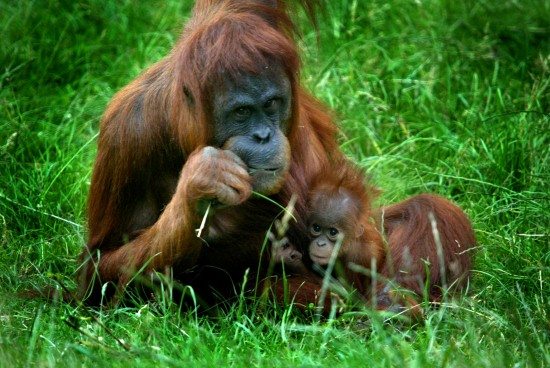
This system is common at rehabilitation centres in Borneo and Sumatra. Rather than the youngsters bonding to human carers which can lead to problems once they reach adulthood, they can bond to fellow orangutans. This replaces the emotional bond usually filled between mother and baby.
For the ensuing years they lived together more than amicably, never wanting to be separated from each other. As a youngster Subis had an unfortunate incident when keepers tried to reintroduce her to the older orangutans. Her father Oscar bit her arm and hand which resulted in her losing her middle digit. This healed up quickly and it doesn’t hinder her in the slightest but it is one way that visitors can distinguish who is who between her and Emma. Further efforts to reintroduce were scrapped due to the risk of further injury.
In the early nineties Oscar and Ramona left the collection to go to other zoos in Europe, which made space for Puluh in 1996. All three animals were of a similar age, and young enough to engage in lots of play behaviours, but of the three at that time, Subis was most dominant. It’s hard to recall that time these days, as the group dynamic has shifted so much.
When I first started on the Primate Section in 1998, both Subis and Emma had had pregnancy tests that were positive. It was exciting to have imminent births, not only from a critically endangered species but the first Sumatran orangutan births at Chester since Subis and Emma themselves more than ten years previous. Fully aware of what can happen with hand-reared orangutan females, we desperately wanted to break the cycle of human reared orangutans that grow up with no maternal knowledge and when they themselves give birth do not know what to do.
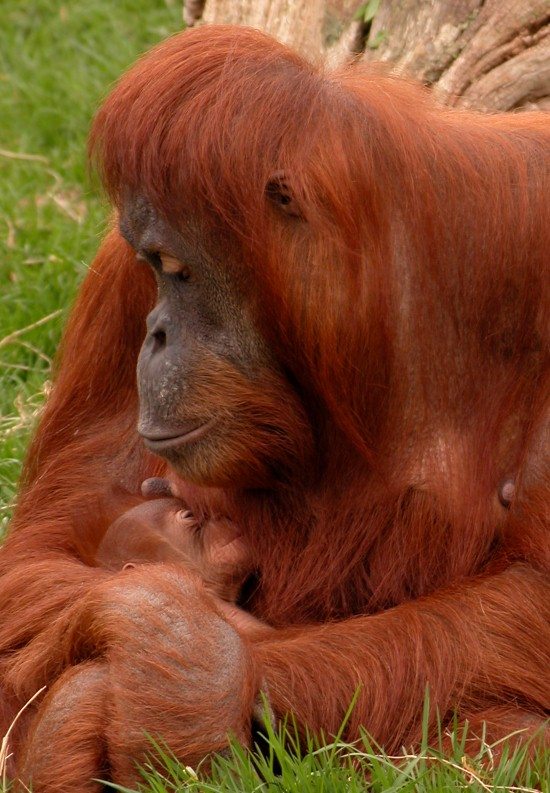
Various options were discussed, such as showing them videos of orangutans giving birth and infants suckling, training to hold a doll, if it was an option we considered it. The option we went for that actually achieved success was introducing them to their Bornean neighbours who they had previously always been kept separate from.
Bornean orangutans and Sumatran orangutans will produce hybrid offspring, so the two species are always kept apart. At that time we had a Sumatran area with the corresponding signage and the same for the Borneans. With a part of the keepers morning spent juggling the animals about between areas, we were able to leave Puluh on his own every alternate day and introduced Subis and Emma to our Bornean females Martha and Sarikei.
Both Bornean females had infants, aged two and three which occasionally still suckled from their mothers. Marthas infant ‘Leia’ was quite reserved, but Sarikei’s infant ‘Matu’ was a confident little soul. I can remember opening a slide to give the four females and two infants access to one another in neighbouring day yards. Subis and Emma stayed put in their yard, Martha and Sarikei stayed put in their yard. Leia stayed with her mother but little Matu went through to join Subis and Emma.
He trundled up to them to investigate the potential new play mates. Fearful that Matu’s confidence would be his undoing (e.g if Subis or Emma became aggressive towards him without Sarikei at arm’s reach to come to his rescue) it was amusing to see the complete opposite reaction. Subis and Emma’s main reaction seemed to be ‘What is that?’ Confronted by a quickly advancing strange ‘pygmy’ orangutan they retreated in shock! Over the next few weeks all the individuals became fairly relaxed around one another and it was both a surprise and encouraging to find Subis cuddling Matu one day.
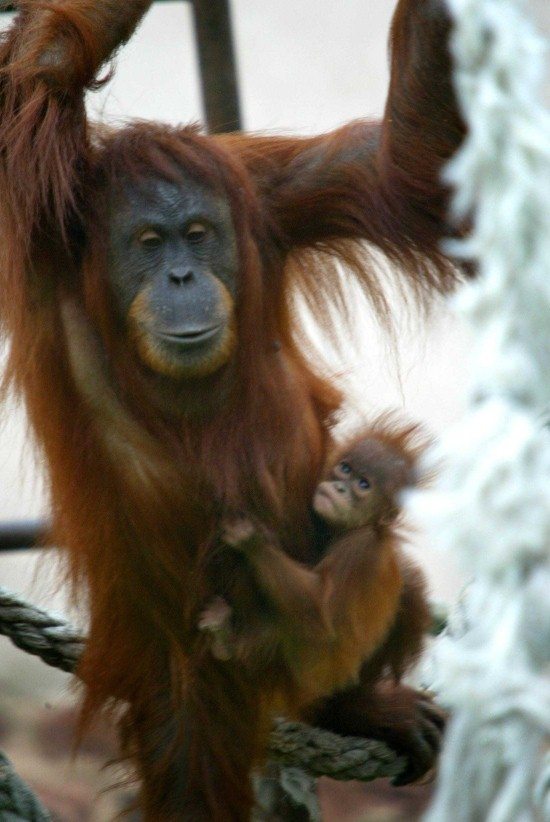
A couple of months later Subis gave birth to a female infant we named Jambi. Her maternal instincts kicked in and we breathed a sigh of relief. Subis was a little rough with Jambi, plucking her on and off her chest and after a couple of months began a behaviour which was even less positive. It seemed that at times Subis got bored of having the infant in tow and would set her down, and occupy her time doing other things other than playing mother.
It was worrying that she was doing this but Jambi continued to grow with no detriment to her welfare. Aside from the incident I described earlier in the blog about Puluh another memorable incident occured during this time. When people ask me ‘How intelligent is an orangutan’ this is one of the examples I give as to their thought process. At this point in time Emma (who was still pregnant) was very much dominated by Subis and if she tried to interact with an abandoned Jambi, she had to beat a hasty retreat as Subis came back to collect her daughter.
On one occasion I happened to be checking on the orangutans during the day and reached the Sumatran Orangutan yard to see Emma with Subis & Jambi sat on the platform in the yard. Subis plucked the baby from her chest and set her down on the platform as she went for ‘a break’ at the other end of the climbing frame.
Emma was now well aware to leave the baby alone or feel Subis’s wrath so sat quietly staring at me, but obviously had Jambi in view from the corner of her eye. Jambi was now able to slowly crawl and move herself, and a wave of sickness hit me as the baby crawled closer to the edge of the platform. There was a thin substrate on top of a concrete floor but if she fell off she could badly injure herself.
Before I could call Subis, in an effort to get her attention and get her to come to Jambi’s rescue, Emma intervened. She quickly looked behind her, checked that Subis wasn’t looking in her and Jambi’s direction, then shot out an arm, grabbed Jambi and slid her back to the centre of the platform. She then let her go and carried on sitting as she had been, apparently paying no attention to the youngster.
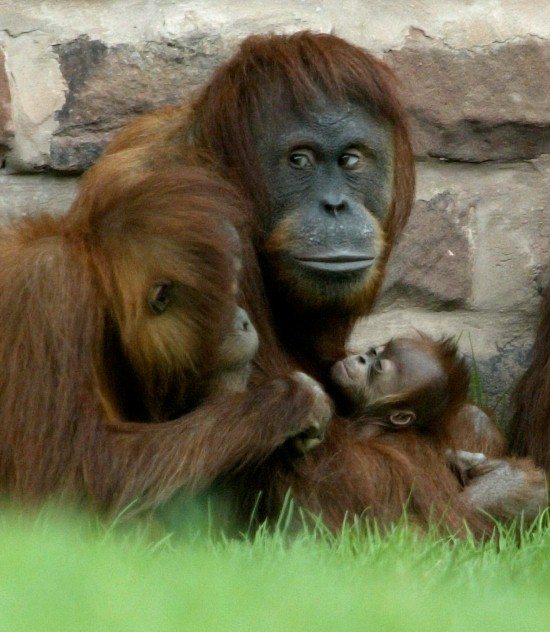
I interpreted the chain of events as Emma weighing up the situation that the baby was in danger, whilst simultaneously not wanting a confrontation with Subis for intervening. Clever Emma! When Emma gave birth later in the year she became protective to her own baby and no longer let Subis rule the roost. By this stage she had in fact become a more solidly built orangutan than Subis. These days it is now Subis that gets out of Emma’s way! With each successive birth Subis and Emma’s mothering skills have improved immensely and certainly after their respective third infants have now become perfect mothers.
In 2007 all the Sumatran orangutan group were moved over to the new Realm Of The Red Ape exhibit, and aside from a very cautious Puluh, the rest of the group were clambering all over the place in no time. We thought that the infants would stay close to Subis and Emma but the new exhibit just seemed to herald ‘playtime’. One thing we didn’t foresee in the planning process was Subis and Emma’s desire to take a closer look at the visitors.
To protect the windows from damage and to stop the orangutans dirtying them they were designed so the orangutans couldn’t sit directly at the glass. Emma and Subis proved their inventiveness by taking free hanging pieces of strapping and threading them through the mesh adjacent to the windows. By tying the strapping they form makeshift hammocks and recline in relative comfort (if you’re an orangutan) to get a good view of the visitors that pass through the building.
The exhibit and the husbandry we practice in Realm Of The Red Ape (RORA) seems to encourage independence, allowing the infants much more scope to move around and interact with the other orangutans (and gibbons) than in the old building. All the infants born and raised since moving to RORA are what I would call nice, steady, confident individuals. Similar husbandry will be adopted when our Sumatran group move to a new building upon the completion of ‘Islands’ and it will be interesting to see them explore their new home and settle in.
As I approach the end of this blog I think it’s apt that all the offspring from Puluh, Subis and Emma get a mention. Jambi born to Subis in September 1998 went to Budapest Zoo in 2007 and now has a daughter herself, born in 2010 named Moira. Padang born to Emma in November 1998 went to Prague in 2010 and he sired ‘Diri’ born early in 2013. Utara born to Emma in March 2004 is still with us, but plans are in motion for her to be relocated to another zoo. Budi born to Subis in June 2004 went to Basel in 2012. Kirana born to Subis in February 2009, Indah born to Emma in February 2008, Tripa born to Emma in October 2012 and Tuti born to Subis in December 2012 are all growing up nicely.
Each orangutan is very much an individual, and their characters blossom as they grow and watching them develop is one of the best parts of the job.
I’m Chris Yarwood and I Act for Wildlife.
“Martha is the oldest primate at the zoo, born in 1965, and has been at Chester Zoo since 1966. She was brought to the zoo, as a baby, by a lady named Barbara Harrisson, who was the wife of the curator of the Sarawak Museum. Following the receiving and raising of an orphan orangutan, she went on to study wild orangutans and care for more orphans. She wrote the first book solely dedicated to the orangutan, aptly named ‘Orangutan’ which was published in 1962. It’s still very readable if you can find a copy! She also helped set up the first orangutan rehabilitation centre.
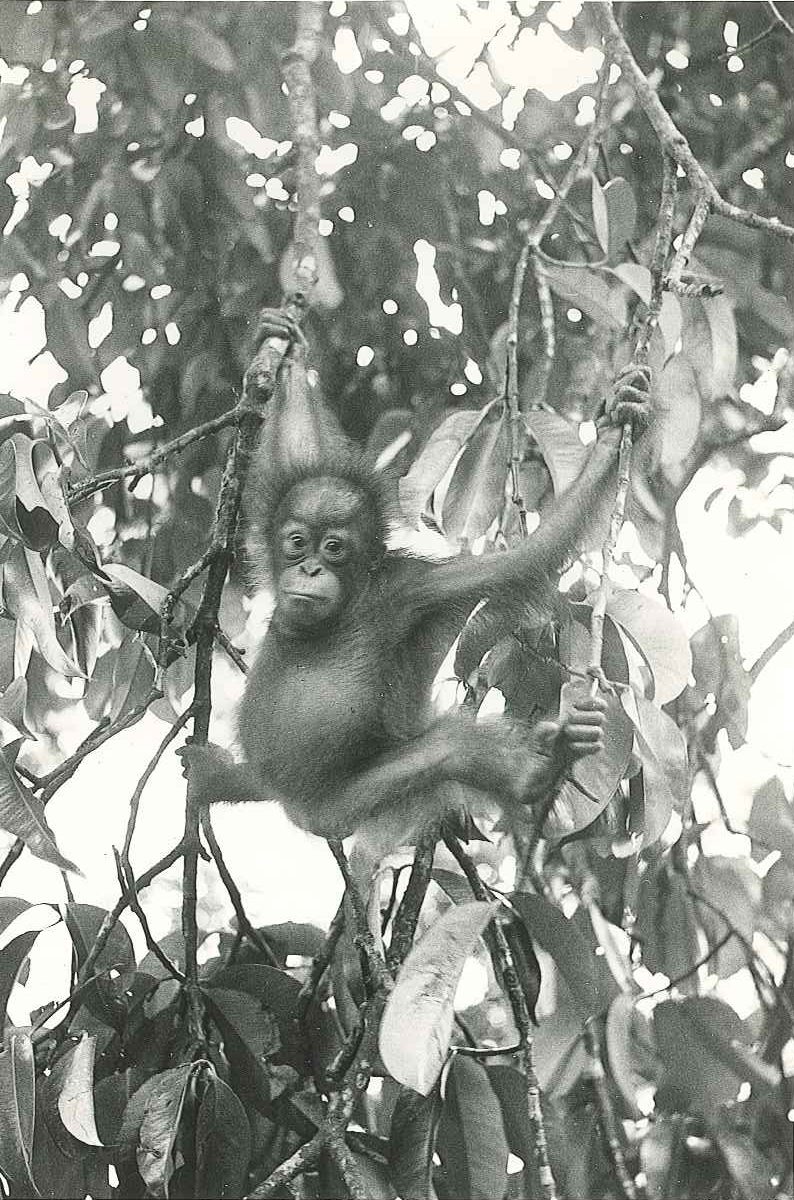
“Martha was brought to Chester Zoo as she unfortunately couldn’t be returned to the wild – Martha does have a stunted index finger and this may have been perceived as a hindrance to her.
“Martha was a very pretty orangutan baby and the earliest photos of her that appear in old zoo publications show her admiring herself whilst holding a small mirror. When she arrived she lived in the old Monkey House, in 1969 she became one of the first inhabitants of the Ape House which held all of our orangutans until the completion of Realm of the Red Ape in 2007.
“Today her outdoor habitat is part of Realm of the Red Ape, and lives here with the other Bornean orangutans; as the Sumatran orangutans have moved over to Islands.
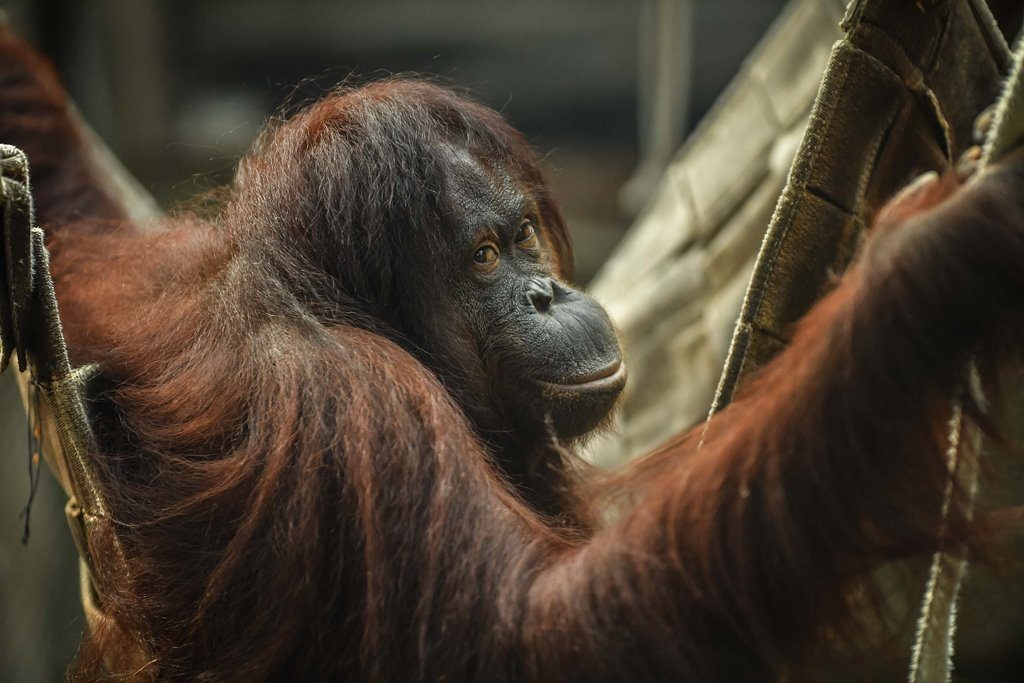
“As Martha matured she became a mother to many offspring and reared the babies herself, following a couple of attempts that resulted in keepers needing to hand rear. This ability to rear her own young, alongside another Bornean female, has paved the way for the rest of the orangutans that have bred at Chester to learn from her. It’s been over 25 years since an orangutan had to be hand reared here!
“Following a few years with no Bornean orangutan male being present at Chester, Tuan arrived from Antwerp. We kept our fingers crossed that Tuan could deliver the goods and within months Martha’s daughters Sarikei and Leia were both pregnant, but despite repeated matings between Tuan and Martha babies never arrived so we assume she can no longer conceive.
“Today Martha shares her enclosure with her two daughters, and also her grandchildren Iznee and Latifah. She doesn’t socialise with her relations much, which isn’t uncommon as socialising isn’t really built into an orangutans DNA, but when she shared her space with a gibbon was surprisingly quite at ease sharing a hammock with the lesser ape.
“Through the years she has mellowed quite a lot. When I first started working with her in 1998 I would have described her as cranky and cantankerous, but now she ambles along at her own pace and enjoys a bit of attention from the keepers.
“She is still very inquisitive and often sits in a hammock watching the world go by. If it’s a particularly bright day she will sit with a hand over her eyes to shielding her gaze from the sun.
“It is estimated that the lifespan of a wild orangutan is approx. 40 years. The current record holder for the oldest orangutan in a zoo is a female Sumatran; Puan at Perth Zoo, who turned 63 in January 2016. (Incidentally, Puan is also mother to Puluh our Sumatran male!) We all hope that Martha will be with us for a long time to come and we owe her a great deal for teaching the other orangutans to rear their own offspring.
“It is nice to have an animal with so much history and links the early pioneering orangutan conservation work of Barbara Harrisson to our conservation efforts here at the zoo today. Thanks Martha!”
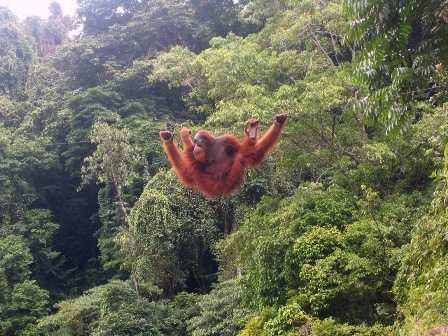
Donate now and 100% of your money will be used to help save orangutans in the wild.
As most people will never get to see an orangutan in Borneo or Sumatra, the two groups living at the zoo act as ambassadors for their species. Chester Zoo currently houses eight Sumatran Orangutans, one adult male, two adult females and their offspring.
“I’ve worked with the orangutans for the last 15 years and for my first ‘blog’ I would like to tell you a little bit about ‘Puluh’ our adult Sumatran male, who is perhaps our most impressive looking ape at the zoo.
Puluh was born in Perth Zoo, Australia in 1987 and arrived at Chester in 1996. When I started working on the Primate Section in 1998 he was a playful orangutan that hadn’t developed his cheek flanges fully. He was however mature enough to father two babies in that same year, the first Sumatran orangutans to be born at Chester for over a decade.
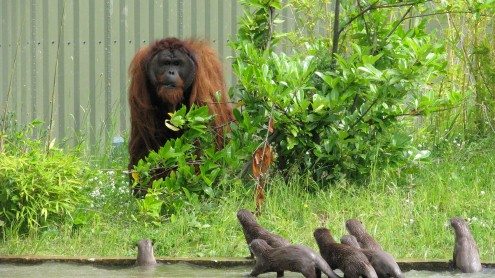
During this time he hadn’t quite bulked out and his two housemates Subis and Emma were of similar size. When the first infant was born we had to make the decision whether Puluh would continue to share the same area as the mothers with infants. Subis was the first to give birth and as she was the most assertive of the three, Puluh was introduced back to them a couple of weeks after Subis’s infant was born once we knew that Subis was rearing the baby ‘Jambi’ without issues.
After a few months Subis started leaving Jambi alone and wandering off a short distance away. One lunchtime (things always happen at keepers lunchtimes!) we got a call to say Puluh had hold of the baby. With heart racing I ran to the orangutan house entered the keeper area and opened up the slides to their night quarters. Emma came in, followed by Subis minus the baby. I secured the two females in one area as Puluh appeared at the slide, standing upright with Jambi lay on her back in the palm of his hand.
In those split seconds it was obvious he was uncomfortable suddenly finding himself ‘holding the baby’ and I was totally powerless as to what I could now do to retrieve the infant. Fortunately Puluh entered the night quarters and gently placed Jambi down on some bedding and retreated back into the yards. I secured the area, went into the bed area to check Jambi, breathed a sigh of relief that she was unharmed and was able to return her to Subis with no adverse effect.
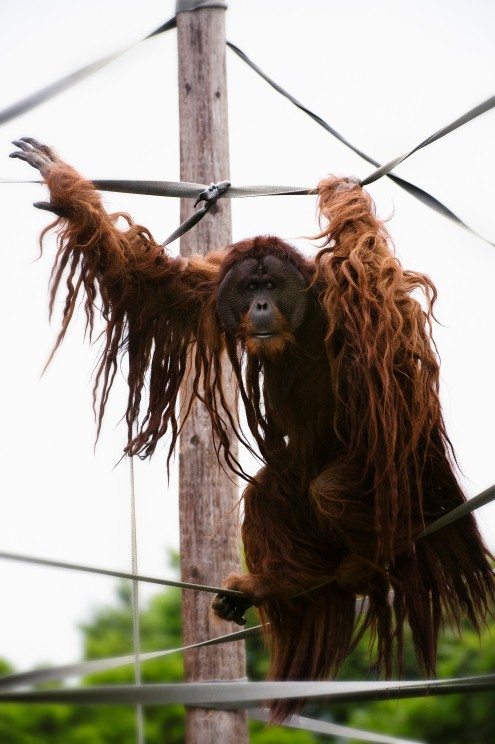
Orangutan males in the wild play no part in the rearing of infants, they do not live in social groups so interaction between adult males and infants does not really occur. Although Subis continued to put Jambi down and temporarily abandon her, Puluh had had his curiosity satisfied and left her alone.
As Puluh has grown to the majestic ape he is today, seven more of his offspring have been born. In his current home ‘Realm of the Red Ape’ we have kept all our orangutans together even as mothers are giving birth. As the babies grow and start to naturally explore their environment they encounter Puluh one on one.
Our gentle giant will hold out a finger to gentley touch them and allow them to investigate his huge hand. As their mobility and curiousness increases we have witnessed babies hanging above Puluh, happily slapping his head.
A younger Puluh would have joined in the boisterous play but our giant just sits patiently with them and quietly enjoys the attention. We our very fortunate that his non-aggressive nature means we never have to separate him from his family. Although I do feel a bit sorry for him if a gibbon, who share Realm of the Red Ape, use his head as a mid-point springboard!
A few weeks ago one of our members showed me a video (thanks Felix), it showed one of our 5 year old orangutans ‘Indah’ being chased by our resident small clawed otters in the outdoor enclosure. Indah ran to Puluh and clung to his side as she would her mother. Puluh swiped at the otter group, making them retreat back into the water. Indah climbed a pole and once safely at the top ‘kiss-squeaked’ her indignation. Puluh glared at the otters for a moment, just so they got the message, then ambled off. Job done! What a great dad!
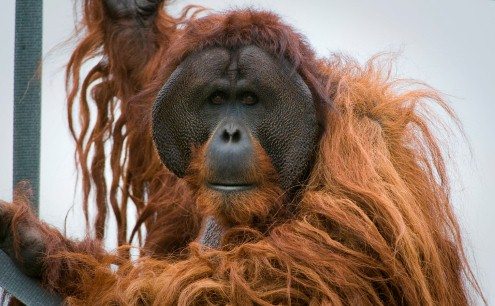
Unlike Emma and Subis, Puluh rarely sits alongside the glass where visitors look into the enclosure, preferring a quieter life away from the attention. But, despite his size, he can be spotted climbing to the top of the tallest poles to survey the neighbouring areas of the zoo, or swinging from rope to rope with his fantastic coat trailing through the air.
In 2010 we managed to weigh all our orangutans by encouraging them to climb a rope which was attached to a digital scale above their enclosure. We could finally give an answer to the commonly asked question ‘How much does he weigh?’ …the answer being 95.5kg. Subsequent ‘weigh-ins’ have been between 90kg and 96kg.
He is a lovely animal to work with, sometimes a bit difficult only due to something new being in the area, or unexpected noises that cause him to be unco-operative in moving between areas (to allow keeper access to clean). But we can let him off with that because the boy is undoubtedly a star!”
I’m Chris Yarwood and I Act For Wildlife
You can make a difference! Register for Go Orange, make a donation, or share our campaign.
